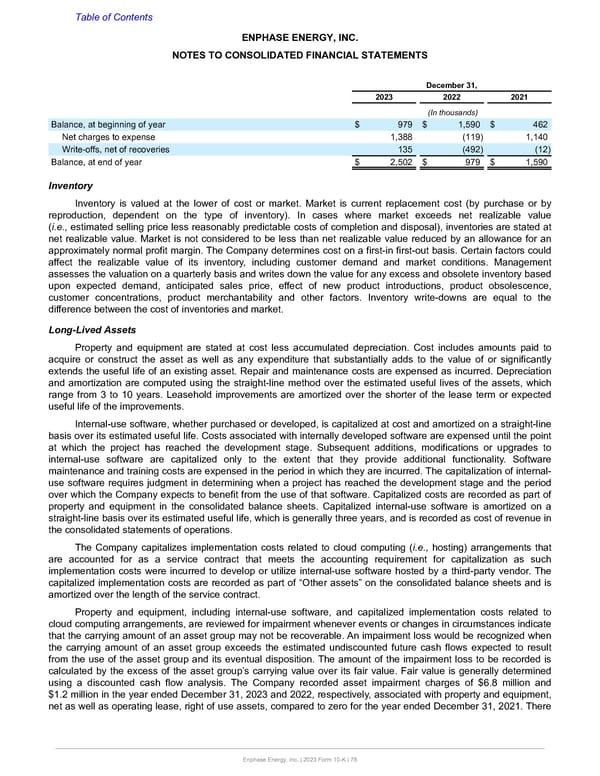Table of Contents ENPHASE ENERGY, INC. NOTES TO CONSOLIDATED FINANCIAL STATEMENTS December 31, 2023 2022 2021 (In thousands) Balance, at beginning of year $ 979 $ 1,590 $ 462 Net charges to expense 1,388 (119) 1,140 Write-offs, net of recoveries 135 (492) (12) Balance, at end of year $ 2,502 $ 979 $ 1,590 Inventory Inventory is valued at the lower of cost or market. Market is current replacement cost (by purchase or by reproduction, dependent on the type of inventory). In cases where market exceeds net realizable value (i.e., estimated selling price less reasonably predictable costs of completion and disposal), inventories are stated at net realizable value. Market is not considered to be less than net realizable value reduced by an allowance for an approximately normal profit margin. The Company determines cost on a first-in first-out basis. Certain factors could affect the realizable value of its inventory, including customer demand and market conditions. Management assesses the valuation on a quarterly basis and writes down the value for any excess and obsolete inventory based upon expected demand, anticipated sales price, effect of new product introductions, product obsolescence, customer concentrations, product merchantability and other factors. Inventory write-downs are equal to the difference between the cost of inventories and market. Long-Lived Assets Property and equipment are stated at cost less accumulated depreciation. Cost includes amounts paid to acquire or construct the asset as well as any expenditure that substantially adds to the value of or significantly extends the useful life of an existing asset. Repair and maintenance costs are expensed as incurred. Depreciation and amortization are computed using the straight-line method over the estimated useful lives of the assets, which range from 3 to 10 years. Leasehold improvements are amortized over the shorter of the lease term or expected useful life of the improvements. Internal-use software, whether purchased or developed, is capitalized at cost and amortized on a straight-line basis over its estimated useful life. Costs associated with internally developed software are expensed until the point at which the project has reached the development stage. Subsequent additions, modifications or upgrades to internal-use software are capitalized only to the extent that they provide additional functionality. Software maintenance and training costs are expensed in the period in which they are incurred. The capitalization of internal- use software requires judgment in determining when a project has reached the development stage and the period over which the Company expects to benefit from the use of that software. Capitalized costs are recorded as part of property and equipment in the consolidated balance sheets. Capitalized internal-use software is amortized on a straight-line basis over its estimated useful life, which is generally three years, and is recorded as cost of revenue in the consolidated statements of operations. The Company capitalizes implementation costs related to cloud computing (i.e., hosting) arrangements that are accounted for as a service contract that meets the accounting requirement for capitalization as such implementation costs were incurred to develop or utilize internal-use software hosted by a third-party vendor. The capitalized implementation costs are recorded as part of “Other assets” on the consolidated balance sheets and is amortized over the length of the service contract. Property and equipment, including internal-use software, and capitalized implementation costs related to cloud computing arrangements, are reviewed for impairment whenever events or changes in circumstances indicate that the carrying amount of an asset group may not be recoverable. An impairment loss would be recognized when the carrying amount of an asset group exceeds the estimated undiscounted future cash flows expected to result from the use of the asset group and its eventual disposition. The amount of the impairment loss to be recorded is calculated by the excess of the asset group’s carrying value over its fair value. Fair value is generally determined using a discounted cash flow analysis. The Company recorded asset impairment charges of $6.8 million and $1.2 million in the year ended December 31, 2023 and 2022, respectively, associated with property and equipment, net as well as operating lease, right of use assets, compared to zero for the year ended December 31, 2021. There Enphase Energy, Inc. | 2023 Form 10-K | 78
 Annual Report Page 77 Page 79
Annual Report Page 77 Page 79